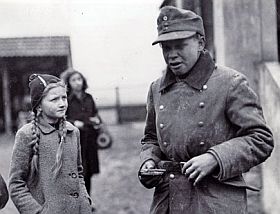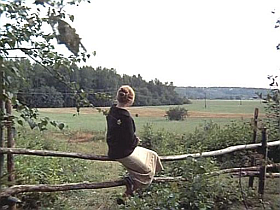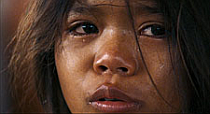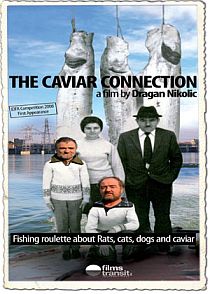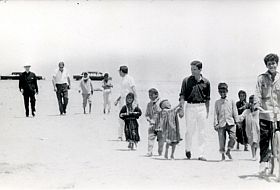Tue Steen Müller fortalte os under sin workshop i Randers, 7BEST om Audrius Stonys “The Bell”, som betog os alle ved sin ro, dybde og skønhed, at instruktøren “kan sin Tarkovskij forfra og bagfra”. Det får vi nu lejlighed til at se nærmere på i morgen aften, onsdag i FOF filmklubben, hvor vi skal studere “Spejlet”. Allerede ved at se klippet her, med scenen med kvinden på hegnet, på You Tube, går det op for én, hvad Müller mener. I billede efter billede ser man det, og tydeligt bliver det med den helt direkte reference til ild/vand motivet og i scenen med det brændende hus og i åbningsscenen (billedet), hvor en pludselig vind bevæger kornet og løvet og hans jakke, da han igen efter deres møde, hvor han har fortalt hende om den besjælede natur, går ned mod vejen ved busken. Alt det er med i Stonys film, hvor han så videreudvikler tankerækken efter sin Tarkovskij-læsning, lægger sit dokument ved siden af, dokument ved dokument er kunstens metode, og begge film bliver rigere for øjnene af os.
En medarbejder ved det videnskabelige akademis institut for fysik i Moskva sendte i 1975, kort tid efter premieren, Andrej Tarkovskij et notat, som havde været sat op på opslagstavlen i instituttet. Tarkovskij bringer det i sin bog om filmkunst, -æstetk og -poetik. Efter han i indledningen har citeret en række private breve og offentlige anmeldelser, som finder filmen uforståelig og elitær. Denne anonyme teoretiske fysiker ser anderledes på det:
“Visningen af Tarkovskij-filmen “Spejlet” vakte på Videnskabsakademiets fysiske institut en lige så stor interesse som tidligere overalt i Moskva. Ønsket om et personligt møde med instruktøren kunne desværre kun opfyldes for ganske få (for forfatteren til denne notits lykkedes det desværre heller ikke). Det forblev ubegribeligt for os, hvorledes Tarkovskij med filmiske midler kunne skabe et filosofisk tilbundsgående værk. Biografgængeren har i den grad vænnet sig til at forvente en fabel, en handling, forvente helte og sædvanligvis en happy end. Derfor søger man så også i Tarkovskijs film den slags elementer og går af samme grund skuffet hjem, for ingen af disse overhovedet findes deri.
Hvad handler denne film da om? Om mennesker. Naturligvis ikke om dette konkrete menneske, hvis stemme Inokentij Smoktunovskij har overtaget off. Nej, det er meget mere en film om dig selv, om din far og om din farfar. En film om de mennesker, som vil leve efter dig, men som ikke desto mindre alle er “du”. Det er en film om mennesker, som lever på denne jord, og som er en del af denne jord, som på samme måde omvendt er en del af dem, af disse mennesker. En film om dette, at mennesket må indestå med sit liv for både fortid og fremtid. Denne film må man slet og ret se, se Rerbergs billeder og lytte til Bachs musik og lytte til Arsenij Tarkovskijs digte. Og ganske vist er man nødt til at se den på samme måde, som man betragter stjernerne, havet eller et skønt landskab. Matematisk logik må man undvære her. Men til syvende og sidst forklarer denne jo heller ikke, hvad mennesket egentlig er, og hvori meningen med dets liv består.”
Andrej Tarkovskij: Spejlet, Mosfilm, Rusland 1974. 91 min. Med Margarita Terekhova. Kamera: Georgi Rerberg. Findes i DVD bokssættet Andrei Tarkovskij collection 2008. Litt.: Andrej Tarkowskij: Die versiegelte Zeit (Sapetschatljonnoje Wremja), Frankfurt/M 1984.



